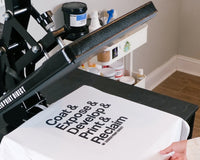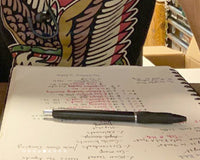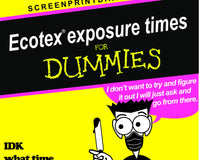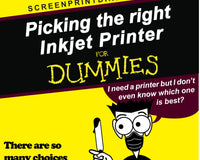Not all screen printing mesh is the same. The lower the mesh count the more ink will pass through the screen and vice versa. In simpler terms...
Low mesh count = more ink on the garment
High mesh count = less ink on the garment
Consider the following before choosing a mesh count:
- The type of ink you are using (specialty, plastisol ink, water-based ink, UV-ink)
- Art - Is your art simple? Have fine detail such as a halftone?
Making these distinctions before you print will save you time and money on the press.
Use the mesh guide below to choose the right mesh for your next job.
40 Mesh - This is not a commonly used mesh size and should be used for specialty inks such as glitters and shimmers. This mesh has large "pores" and will allow ink with larger particles to pass through. Using standard plastisol ink on this size would be very messy because it would allow too much ink to pass through the screen.
Typically, anything from 40-86 mesh should be used for specialty inks with larger particles.
110 Mesh - This mesh count is good for prints with low detail such as large block text or simple art. It is used to put down heavier ink deposits. Heavier ink deposits are used specifically when printing with an under-base or getting a light color to pop on a dark garment. It is important to note that heavier ink deposits will create a thick layer of ink and not as soft of a hand.
137 Mesh - This is the golden mesh. 137 is the perfect mesh for all your standard plastisol inks. It produces a nice layer of ink with good detail.
155 Mesh - Similar to 137 but will hold a bit more detail for finer prints. This mesh allows less ink to pass through therefore producing a softer feel.
155 and Up Mesh - This is the recommended mesh for Water-Based Inks/Discharge Inks.
230 Mesh - Use this mesh for your most detailed of prints such as halftones. While this ink produces an extremely soft hand feel, the ink deposit passed through the screen is very light resulting in less vibrant prints.
It is important to note that the 230 mesh sold here at Screen Print Direct® is yellow. Yellow mesh will increase your exposure time. If you expose with the same time as you would white mesh, your screen will be under-exposed.
Suggestions:
We suggest experimenting with different screen meshes. Not all mesh is the same and neither are printers. Do you prefer bolder prints? A softer hand feel? What about your customer, what do they like? Experimenting with different mesh screens will expand your skill set and allow you to offer more to your customers.
Let's Talk
Remember, we are here to help! Drop a comment below or email our support team at info@screenprintdirect.com








3 comments
Terry
I usually use 110 mesh with white plastisol ink and it works great. Today I’m using mesh around 160 and it’s putting too much ink down and it’s flooding the image with ink. Does that make sense?
Celso Cortez
How can I get a proper mesh count for my project without spend to much money, can you send sample size, and how much would them cost?
Gautam Paul
I want to purchase mesh clothe for frame of Screen print.